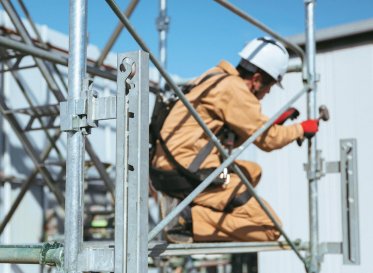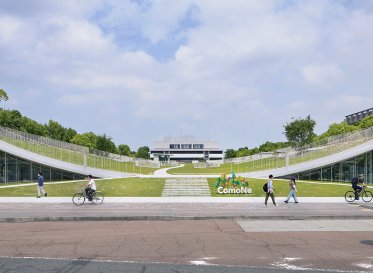
Designing AkeruE, Japan’s First Creative Museum To Nurture The Creativity Of The Next Generation
OUTLINE
Panasonic Corporation has opened AkeruE, a new “creative museum” on the 2nd and 3rd floors of the Panasonic Center Tokyo in Ariake, Tokyo. Loftwork helped create this new facility.
The concept of AkeruE is “a museum that gives shape to inspiration”, with three exhibition and experience spaces – ASTRO for encountering wonder, COSMOS for building and playing and PHOTON for communicating and connecting. AkeruE is a place where children can learn about art, science and engineering through hands-on experiences, and where they can practice and communicate their knowledge.
AkeruE is a new type of educational exhibition facility that allows children and young people to develop their creativity, which is essential in the VUCA era.
PROJECT SCOPE
In this project, the LAYOUT unit, a Loftwork team specializing in space production, partnered with Panasonic to provide full support for the opening of the new building, including concept planning, space design direction, content planning and communication tool production.

OUTPUTS
Japan's first creative museum
AkeruE concept movie

AkeruE combines elements of a science museum that nurture the intellect with those of a museum that nurtures the senses, fostering creativity through learning and experience. It integrates the fascination of science and mathematics with the fields of engineering, technology and art. Through the experience of seeing, creating and communicating, the museum supports children’s creative activities and the development of the next generation of leaders.
There are six areas on the 2nd and 3rd floors of the Panasonic Center Tokyo that help to give shape to children’s “inspiration”.


Exhibition & Experience
“ASTRO” – The Wonder Of The World
An exhibition area showcasing STEAM works by up-and-coming artists, combining science, technology, engineering, mathematics and art.
In addition to the works on display, there are also 16 main exhibits that break down the principles and mechanisms that make up the works and allow visitors to learn through hands-on experiences. For example, for a work that plays music through sensing different color lines drawn arbitrarily on a piece of paper, visitors can experience the work’s programming, color sensor and speaker mechanisms.




"COSMOS" – Let's Make And Play
The theme of the COSMOS area is “Let’s make and play”. In this area, children can freely make creations using recycled materials. After taking photos of their works and displaying them on the stand in the middle of the space, AI using sensor technology curates the display and highlights specific creations. The result is a diverse world created through the combination of the children’s works.




“PHOTON" – Communicate And Connect
This is a space where visitors can experience the theme of “connecting through communication”. There is a mini-studio and a stage for filming, where visitors can shoot and produce their own videos. The finished videos will then be archived and shown on a giant screen in the PHOTON space and on AkeruE’s official YouTube channel.



Space design
Five spatial keywords to stimulate creativity
In order to motivate the visitors and staff to be creative, the team set five key phrases for the AkeruE space: “You can do it yourself”, “You can make it yourself”, “You can recombine it”, “You can’t put it in a box” and “We can have a session together”. The space was designed and implemented in a way where these elements can coexist in an optimal balance with exhibition themes and the activities in each area.




Creating spaces and experiences that are sustainable
With the goal of creating awareness of the United Nations’ Sustainable Development Goals for the next generation, the design of the space and the furniture takes into account continuity, renewability and sustainability. Up-cycling and the 3Rs (Reuse, Reduce, Recycle) are the driving forces behind the creativity of the space, which also reduces demolition costs by using existing space.



AkeruE is the successor to Panasonic’s RiSuPia, a facility that supported the development of the next generation. To renew the space, the team upcycled the ceiling materials used in RiSuPia into a tool wall. In addition, they worked to minimize the number of repairs, for example, by using the remains of the original exhibition as a historical reference for the design of the facility.
VI & Logo

AkeruE’s logo consists of a simple circle, a universal shape used in all forms of expression. The five circles, which represent the five senses, are grouped together inside the larger circle to express a space where we can learn principles from nature and art and give shape to our inspirations.
In addition, small circles are placed at each of the following angles from the horizontal and vertical through the centre of the large circle: the angle of the earth’s axis (23.4 degrees), the bonding angle of water molecules (104.5 degrees), the angle of the golden ratio derived from the Fibonacci sequence (137.5 degrees) and the internal angle of an equilateral triangle (60 degrees). This embodies the idea of the museum as a place where students can learn principles from nature and mathematics, observe events and discover their own imagination.
Tools & Signs
The team created about 150 tools for the museum, including signs, handouts, posters and maps. These include an “inspiration notebook” to be handed out to visitors as a way to explain AkeruE’s unique learning cycle of “Encounter with wonder”, “Let’s make and play” and “Let’s communicate and connect”.






STORY
Implementing a cross-sectoral education for living in the VUCA era
For 14 years, since 2006, the 2nd and 3rd floors of Panasonic Center Tokyo were home to RiSuPia, a hands-on museum based on the concept of getting in touch with the fascination of science and mathematics. With a cumulative total of 4.6 million visitors and nearly 20,000 school institutions, RiSuPia has significantly contributed to the development of the next generation.
As the current trend in education shifts from “field-based learning” to integrated learning that crosses multiple areas of knowledge, the project team proposed updating the facility into a “creative learning space” based on STEAM (Science, Technology, Engineering, Mathematics and Art) and Creative Learning (learning by making).
Creative Learning is an educational scheme proposed by Professor Mitchell Resnick of the Massachusetts Institute of Technology (MIT) Media Lab. This concept is also in line with the philosophy of Panasonic’s founder, Konosuke Matsushita, who advocated “creating people who create”.
Our aim was to create and share facilities that go beyond the “hands-on” experience. As such, the team created Japan’s first “creative museum”, which is both a science museum and an art museum, but also an atelier and a laboratory.

Managing a complex project involving 100 members, while overcoming the COVID-19 pandemic.
With the goal of creating Japan’s first creative museum, a space yet to be seen, the team broke the project up into seven areas: business planning, spatial design, branding, content planning, operational design, PR and communication tools.
In addition to Panasonic and Loftwork, the project team included a total of nearly 100 members, including Nomura Kogeisha, who were responsible for spatial design and implementation; creators involved in the planning and production of content such as exhibitions and facility programs; and management staff. A complex project management was required to integrate all these activities. The team also had to manage and carry out complex projects without always knowing what the future would bring, such as the six-month suspension of activities in 2020 due to the coronavirus pandemic.
Due to the different tools available to each stakeholder, the number of communication tools in use during the project included 9 workspaces (178 channels) on Slack, 10 workspaces (452 threads) on Basecamp and more than a dozen messenger groups. Loftwork members used these tools to communicate, working across these channels and threads to carefully track in detail the activities in their own areas of responsibility and to create an environment where PMs in other areas could always see the progress and status of the project to ensure smooth collaboration.
In addition, as a way of motivating the team in the face of an uncertain future, the team shared the concept documents, which were updated on a daily basis, with project members in all areas. This created a situation in which the project managers in each area could make the right decisions on the spot, and also fostered an atmosphere in the team that the project must be completed.
Project overview
Client: Panasonic Corporation
Project: Panasonic Center Tokyo 2-3F Renovation Project
Structure
Loftwork Inc.
- Producer: Hajime Matsui
- Project Management: Haruka Koshimoto
- Space Direction: Satoshi Kawamura
- Exhibition direction: Natsuki Sagawa, Mariko Takeda, Mio Iizawa
- Management design: Misaki Kawai, Nahoko Kosuge, Akiko Asai, Kyohei Tanahashi, Ken Nakamura
- Website development: Takuro Iijima, Masumi Murata, Oriko Kitajima, Naoto Uemura, Ryoudai Minagawa, Nao Niizawa
Production partners
- Program design: Motoi Chikamori (plaplax), Junpei Suzuki (unworkshop)
- VI and signage design: Tomohiro Okazaki (SWIMMING)
- Exhibition production by:
- Yoshiyuki Inoue (Pantagraph)
- Yuzuki Kunitaka (Mondo Works Co., Ltd.)
- Sachiko Kodama (Media Artist, Associate Professor at the University of Electro-Communications), Minako Takeno (Ceramics Experience Labkai)
- Yuuri Suzuki (sound artist, partner of Pentagram)
- Akiko Nakayama (painter)
- Kazumi Maekawa (Researcher and Artist, Research Center for Advanced Science and Technology, The University of Tokyo)
- Takuya Matsunobu (Engineer, Designer),Yasuaki Kakehi (Interactive media researcher, Associate Professor, Interfaculty Initiative in Information Studies, The University of Tokyo)
- Toshiya Yui (Media Artist), Tomohiro Yokota (Engineer), Tomoko Hashida (Researcher)
- Exhibition design:
- Akane Yamaguchi (Nomura Co., Ltd.), Sayaka Koga (Nomura Co., Ltd.), Ayumi Sasai (Nomura Co., Ltd.), Kiyoho Tani (Nomura Co., Ltd.), Miriyuki Nakade (Nomura Co., Ltd.)
- Web Design
- Yukihiko Yoda (yodadesign)
Member

Misaki Kawai
Loftwork Inc.
Layout Director

Mariko Takeda
Loftwork Inc.
FabCafe Creative Director

Naoto Uemura
Loftwork Inc.
Creative Director

Ryota Minagawa
Loftwork Corporation
Creative Director

Akiko Asai
Loftwork Inc.
Layout Unit Director

Rio Shinzawa
Loftwork Inc.
Producer
Next Contents




















